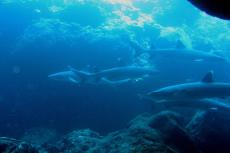Sharks and Rays Receive CITES APPENDIX II Protection!
CITES voted today on proposals to list silky sharks, all three species of thresher sharks and all nine species of mobula rays on Appendix II.
Silky and thresher sharks have shown declines of between 70 and 80% across their ranges, with local declines of more than 90%. Mobula rays are declining as well, and have become more heavily targeted since manta rays received CITES protection in 2013. All three species are wide-ranging with a global distribution, and all proposals were drafted by large collaborations of more than 20 coastal countries, representing all oceanic regions.
Proposal #42 added silky sharks to Appendix II. Silky sharks are the species most commonly caught as bycatch (fishes caught accidentally when targeting other species) in longline and purse seine fisheries. There is targeted fishing for silkies as well, both for meat and for the shark fin trade. This proposal drew strong support, with Mexico, Chile, Bahrain, the DRC, Jamaica, Ethiopia, New Zealand and Argentina speaking in support of the proposal. Opposition came from Qatar, who was concerned with detrimental effects on coastal fishing populations, and from Japan, who feel that previous shark listings have not yet been fully implemented, and listing additional sharks will place pressure on small fisheries. Also opposed were Nicaragua, Iceland and Indonesia, who believe sharks are best managed by regional fishery organizations rather than global regulation. The influential Fisheries & Agriculture Organization of the United Nation (FAO), an organization concerned primarily with global food availability rather than conservation of species, spoke against CITES listing for silky sharks, preferring regional control of the species. Despite this opposition, by a secret ballot requested by Japan, the CITES membership voted with a large majority to list silky sharks on Appendix II!
Proposal #43 moved all three species of thresher sharks to Appendix II. These dramatic and beautiful sharks, with their long caudal fin, are highly prized in the shark fin trade, and are believed to be at the highest risk of extinction of all pelagic sharks. Annual takes of thresher sharks are difficult to determine, as many animals move secretly into the fin trade, but it is believed that well over one million thresher sharks may be harvested annually. Opinions for and against the thresher shark listing followed a similar pattern to the silky proposal, with opposition voiced by Iceland, Japan and the FAO. By secret ballot, as requested by Japan, the CITES membership voted with an even larger majority to list thresher sharks on Appendix II!
Mobula (devil) rays are heavily commercially fished for their gill plates, which are used in Asian medicine, and the global trade in dried gill plates is reported to be more than 120 tons yearly. Mobula rays have a very low reproductive rate, bearing a single pup every 2-3 years, and therefore have limited ability to recover from population declines. Proposal #44 placed all nine species of mobula rays on Appendix II. By secret ballot, as requested by Japan, and despite opposition by….go on, guess who....Iceland, Japan and Myanmar, but surprisingly not the FAO, the CITES membership voted with AN EVEN LARGER MAJORITY to list all mobula ray species on Appendix II!
- Log in to post comments






















